Q Thank you for the informative article recently in the Arkansas Democrat-Gazette about orchids [see the Jan. 19 Style section]. I've dabbled in Phalaenopsis for several years. Since I am frugal to a fault, I mostly get my Phals from Walmart and Aldi's. I have pretty good luck with their plants as I do as you suggest -- new buds, healthy looking plants, etc. However, nowhere can I find the answer to this question -- not even on American Orchid Society website -- what is the normal life expectancy of a Phal, or is there one? I have some that are 10 years and up that are still blooming and some younger that are not. I keep track of the blooming record of each one (I have 13 right now with 10 showing spikes). If they don't bloom after 4 years and I have repotted and given them some TLC, out they go.
A I don't know if you can ever give a life expectancy to a plant. There are just too many variables, beginning with the genetics of the plant, where it was grown, the care it is given, etc. I did a Google search for the oldest living orchid and came up with a plant in the Singapore Botanic Gardens that is 154 years old. That being said, I think you are more than patient to give them four years to bloom or they are gone. I probably would not be that patient. There is only so much room, and there are so many plants to grow.

Q I have shrubs across the front of my house, on the south side. They have grown really well, and we have trimmed them several times over the years. Suddenly this year, I noticed dead branches in two places. I really thought our dog had somehow damaged them. She likes to go between the shrubs and the house. It just made sense that possibly she had uprooted them. After looking closer, however, I'm not sure that that is the problem. Any advice you could give me would be very much appreciated.
A From the picture and the visible damage, it could be caused by a dog if she repeatedly went in and lay down. Are any of the branches damaged or torn? I would assume you have good drainage as it is in a raised bed and the plants seem quite old. One other thing to look for is scale insects. Your shrubs are golden euonymus, which are quite prone to scale insects. Heavy infestations can cause leaves to shed, but typically not in such a pattern as you have. The insects will look almost like a coating of salt and pepper on the backs of the leaves and stems. I would not do any pruning now as we are just beginning to get some really low temperatures. Wait until early March to give the plant a haircut and see if it begins to regrow. If it does not, you may have to replace one shrub. If you do have to replace it, dig up the shrub and take a sample of the roots and stem to your local county extension office and let them send it to the disease diagnostic lab to see if they can find any diseases.

Q We live in Mayflower. Our house backs up to Lake Conway. We have what I believe to be privet shrubs in front of our house that we would like to replace. It faces east and gets morning sun and afternoon shade. What would be a good choice? Also, what's the best way to eradicate the shrubs after we cut them down?
A Thankfully you don't have privet shrubs but a small leafed holly, possibly helleri or yaupon. If you look at the leaf margin you will notice small scalloped edges. Privet has smooth leaf margins but the plants also grow tall -- up to 12 feet or more. Privet blooms with white flowers in the spring, followed by small black berries, which the birds eat and scatter, spreading this highly invasive shrub. The dwarf hollies typically do not flower nor set fruit. Hollies are a fine choice for a foundation planting but they can be a bit boring if that is all you have. Eastern exposure is ideal for many plants. If you want bloomers, consider azaleas, deciduous summer-blooming spirea, dwarf gardenias or compact itea. From the picture it looks like you need relatively short plants at maturity because of the porch. I think diversity is a good thing and adds interest in a garden, so experiment. You have many choices. If you want to ensure that the hollies don't resprout, you need to get them up from the roots. If you can get close enough to the beds with a vehicle, you can wrap the base of a shrub with a chain or rope and pull it out.
Retired after 38 years with the University of Arkansas Cooperative Extension Service, Janet Carson ranks among Arkansas' best known horticulture experts. Write to her at P.O. Box 2221, Little Rock, AR 72201 or email
jcarson@arkansasonline.com
HomeStyle on 02/02/2019
